UNIT 4
Chapter 12
12a
12.1-1 Deriving the Factor Demand Curve
- Outline:
- A firm's demand for a resource like labor is a derived
demand. It is derived from the demand for the product that the
resource produces
- The profit maximizing rule says that a firm hires labor
up to the point at which MRP = MRC (or MRP = W in competitive
labor markets)
- to maximize profits, a firm will keep hiring workers until the
last worker adds just enough revenue to the firm to cover the cost
of that worker
- the demand for labor (by businesses) is a derived
demand, that means it resutls from the demand for the products
that the labor produces
- MRP = change in TR / change in quantity of labor
- MRP = the extra revenue that the firm gets when it hires
one more worker
- MRP = the MB to the firm of hiring another worker
- MRP = MR x MP
- MR = extra output of produding one more unit of
output
- MP = extra output from hirirng one more worker
- for purely competitive product market: MRP = P x MP =
VMP = value of the marginal product
- ME:
- this is just benefit-cost analysis
- they hire all workers where the MB > MC, up to where
the MB = MC
- But, how do we measure the MB of another worker and the
MC of another worker?
- MRP
- marginal revenue product
- the MB that a firm gets when it hires another worker
- Definition: the increase in the firm's total revenue
derived from hiring one additional worker (or any other
variable input
- Formula: MRP = change in TR / change in quantity of
labor
- VMP
- VMP is the Value of the Marginal Output
- VMP is the value (P) of the extra output produce by adding
one more worker (MP)
- VMP = the price of the output (P) times the extra output
produced by the last unit of labor hired (MP)
- P x MP is called the VMP
- if the firm is perfectly competitive then MRP = VMP
- MRP = MR x MP
- but in pure competition we know that MR = P
- so for firm's selling their product in a perfectly
competitve market: MRP = P x MP
- VMP = value of the marginal product = P x MP
- VMP = MRP (for firms in purely competitive product markets
only)
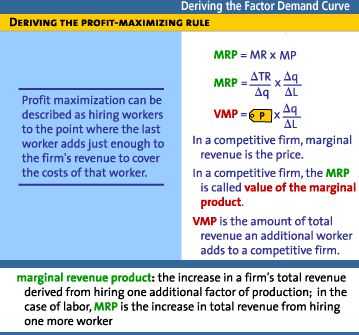
- What is the profit maximizing quantity of labor to hire if the
firm is purely competitive in the short run?
- ME:
- we need to know the extra benefits of hiring one more
worker and the extra costs of hiring one more worker
- then we hire up to the point that MB=MC
- MB of hiring one more worker is the MRP or the amount
that TR increases when we add one more worker
- MC of hring one more worker
- is the MRC
- margnal resource cost
- MRC = change in TC / change in quantity of labor
- so we will maximize profits if we keep hiring as long as
the worker adds more to our revenue (MRP) than it does to
our costs (MRC)
- profit maximizing rule: MRP = MRC
- Given:
- P of TVs = $100
- and the table below
- what is the profit maximizing Q of labor to
hire?
- i.e. where does MRP = MRC, or in purely competitive
product markets, where does VMP = W or MRP = W
- hire as long as the VMP is > wage you have to pay up
to where VMP = W
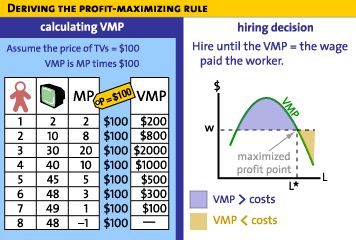
- hire L* number of workers
- thr VMP curve then is the derived demand curve of
labor
- it is also the MRP curve; in purely competitive product
markets VMP = MRP
- So: the demand for labor is the MRP curve
- VMP = P of the product x MP
- MRP = change in TR / change in Q labor
- New rule for maximizing profits in purely competitive
product markets only: W = VMP or W = MRP
- New rule for maximizing profits in purely competitive product
markets: W = VMP or W = MRP
- this is really the same as MR = MC
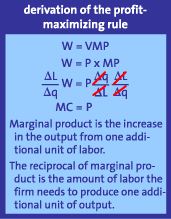
- Now we can draw a Demand curve for Labor
- Remember: DEMAND is a schedule that shows the quantiy
employed at various wages
- we know they will hire the quantity up to where the W = MRP
(or until W = VMP in purely competitive product markets)
- so we can pick different wages and find the quantity of
labor demanded at each wage
- ME:
- the VMP = W rule is only good if BOTH the product
market AND the labor markewt are purely competitive
- a more general rule to maximize profits is: MRP =
MRC
- also, our textbook only shows the MRP (or VMP here) to
be downward sloping, just to keep it simple
- SO, the MRP curve (or VMP here with purely
competitive product ASD resource markets) is the resource
demand curve
- What will change (shift) the demand for labor (resource)?
- anything that changes the demand for thr product (P, P, I,
N, T)
- anything that changes the productivity of the resource
(like technology)
- ME: also, changes in the prices of other resources (but
this is complicated -- see textbook)
- ME: see the textbook for a more in depth discussion of the
determinants of resource (labor) demand
- What happens if you do not have a purely competitve product
market and firms have to lower their prices to sell more?
- then VMP will not be the same as MRP
- to find the profit maximizing quantity to hire: MRP = W (or
VMP = W)
- ME:
- but this is only if the RESOURCE market is
competitive
- a more general rule is: to maximize profits hire labor
up to the point where MRP = MRC
- SUMMARY:
- ALWAYS to find the profit maximizing quantity to hire:
MRP = MRC
- ONLY WITH competitive product AND resource markets: VMP
= W
- ONE MORE THING: since we know compeititve markets are
efficient, then the qallocatively efficient quantity to hire is
where: VMP = W
12.3-1 The Supply of Labor - The Determination of Wages -
Analyzing the Labor Market
- Outline:
- Demand for Labor = MRP
- individual demand
- market demand: horizontal summation
- Supply of Labor
- Equilibrium in the Labor Market
- Demand for labor is the firm's MRP curve
- For ALL graphs in econmics you should be able to answer
three questions:
- what is the relationship being described by the graph?
- what accounts for the slope, or shape, of the curve?
- what would cause the curve to shift?
- for the MRP curve:
- the relationship is the relationship between the wage in th
emarket and the quantity of labor than an individual firm finds
profitable to hire
- the MRP curve is downward sloping because of the
diminishing MP of labor; that is, since each additional workers
produce less additinal output than the previous worker so they
therefore add less to the firm's revenue
- if the MP of labor declines rapidly the demand for labor
(MRP) will be more elastic and a small change in the wage
rate will cause a large change in the quantity hired
- ME: the textbook gives the folowinf determinants of
elasticity of demand for labor:
- rate of MP decline
- ease of resource substitutability
- elasticity of product demand
- labor-cost to total-cost ratio
- the demand for labor will shift in responsese to changes in
two determinants:
- a change in the price of the good or sevice being
produced
- a change in labor productivity
- Market Demand: horizontal summation
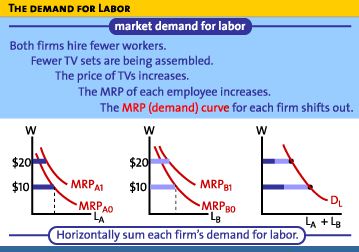
- The Supply curve for labor
- individual households supply labor to businesses
- how much labor will people be willing to supply at
different wages
- tradeoff between work or leisure?
- a backward bending supply of labor curve?
- if wages are high people might decide to work less and
take more leisure - called the income affect
- but the substitutin effect says that if wages are high
people might work more and take less leisure
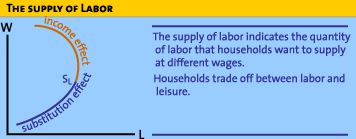
- but usually econmists assume an upward sloping l;abor
supply curve:
- what relationship: the relationship the market wage and
rthe amount of time people want to spend at work
- why the upward slope: because the higher the market wage
the more people want to work
- whar causes the curve to shift: examples:
- lower taxes so people get to keep more of their
income
- if people needed more income like for medical
bills
- if preferences toward work and leisure changed
- Equilbrium
- where the labor D and S cross
- Qs = Qd is equilibrium; why
- if wages are too low then the Qd>Qs and there will be
a shortage of labor or excess demand for labore will bid
wages up through the bidding mechanism
- if wages are too high the the Qd<Qs and there will be
excess supply and the bidding mechanism will drive wages
lower
- shifts in the demand or supply of labor graphs will change
the equilibrium wage rate and the quantity employed
KHAN ACADEMY
MINDBITES
YOUTUBE
BILATERAL MONOPOLY
wage determination in imperfect labour markets 4:37 pajholden
http://www.youtube.com/watch?v=9TnuhpzhlsQ
how are wages determined in labour markets, when a monopsonist and
then a trade union are present?
mjmfoodle
ACDCLeadership
Micro Unit 5: Resource Market Playlist by ACDCLeadership
1. Micro Unit 5 Intro- Resource Markets 1:23 by ACDCLeadership
http://www.youtube.com/watch?v=Y2Z9r4PKwI8&playnext=1&list=PL9EB9C5438D7264E8&feature=results_main
2. 5.1 Market and Minimum Wage: Econ Concep... by
ACDCLeadership
3. 5.2 Perfectly Competitive Labor Market and Firm... 3:27 by
ACDCLeadership
4. 5.3 Comparing Product and Resource Market... by
ACDCLeadership
5. 5.4 Resource Market, MRP and MRC: Econ Co... by
ACDCLeadership
Perfectly Competitive Resource Market Profit Maximization 9:53
APECONREVIEWER
EconProfessorKate
- Monopsony Deadweight Loss 0:49
- Monopsony Graphically 2:00




